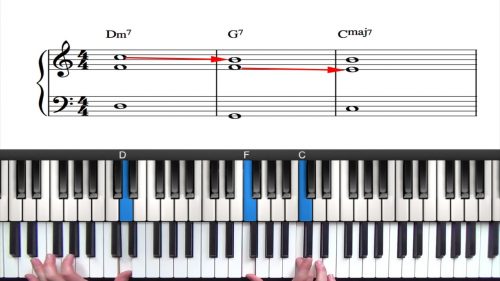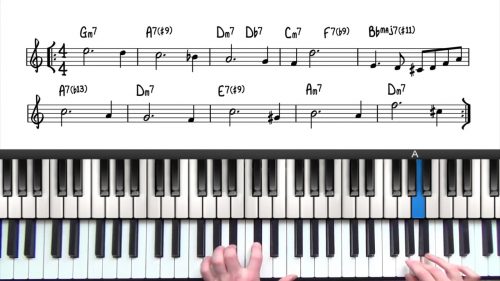Bill Evans Major 251 Line
Bill Evans was a true innovator – revolutionising the sound of the jazz trio. His unique style influenced jazz pianists that came after him and even those who came before him.
Bill Evans’ signature sound was rootless voicings. When the root is omitted, the chords voice lead as smooth as possible – these voicings are perfect to play underneath your right hand solos.
You can play this line whenever you come across a major 251. In the lesson we start of in the key of Bb major and then transpose the line into a couple of other keys. If you have time, take the line around all 12 keys… it will be a great exercise!
Lesson Downloads
-
Bill Evans Major 251 Line Notation File Type: pdf
Practice Tips
-
Memorise this line in terms of the scale degrees.
-
Change the rhythm, add notes in, take notes away. Make it your own.
-
When starting out with transcription, you should identify and transcribe lines over 251 progressions. They will be instantly relevant to many of the tunes you are playing.
-
Don't forget to transpose the lines around a few different keys, or all 12 if you have time!








The problem I am facing now is I can figure the note out in terms of scale degree in that chord and transpose into different key, However, I don’t feel the melody naturally because I think I used to think of melody in terms of the key that is in. Will that be a problem if I tend to think of melody as the scale degree of the key rather than the chord that is in? I practiced using scale degree of the chord but it really feel awkward. Any advice?
Hey Tina 👋
Good question!
When transcribing, I have always analysed the scale degree in relation to the underlying chord, not the underlying key.
I also make note of the scale degree where the chord changes, and I find this helps me apply it to new keys because I have these ‘anchor points’ in mind.
For example, with this line I think of it as the upper extensions over the ii-7 chord (9, 11 & 13) , then i hit the 6/13 of the V7 chord and fall down the basic triad of the V7 chord before resolving into the 3 of the Imaj7 chord.
The 2 key bits of information there, are that the first note I play on the V7 chord is the 6/13, and then the first note I play on the Imaj7 chord is the major 3. It’s very common to resolve into the 3 of a major chord.
I think it’s very important to see and visualise the point of transition from ii-7 to V7, and in particular the point of resolution from the V7 to the Imaj7 chord.
Whilst I’m not discrediting your approach of analysing it in terms of they key, I think this would be a harder task. In addition, it may limit your ability to change, modify, or extend the line. For example, when I am thinking in terms of scale degrees of each chord, I know which scale degrees will sound nice (primary chord tones, extensions, perhaps alterations over the dominant chord.) Now to do that whilst thinking of the key, seems super difficult to me.
I would recommend thinking of it on a per-chord basis.
Something else that has just come to mind… using your approach, how would you analyse a line over a tune such as Blue In Green: pianogroove.com/jazz-piano-lessons/blue-in-green-tutorial/ ?
incidentally, I did transcribe this line from one of Bill Evans’ recordings of this tune. But my point is that most of the form does not follow traditional harmonic frameworks such as 251s. There are two consecutive 251s on the first line, but the rest the chords do not fit into 25s, or 251s as it it is a modal composition. So you would have to analyse the material in terms of the individual chord, not the key.
I hope that makes sense. I’m not saying that my approach is the definitive and correct way to transpose lines. Perhaps other musicians do analyse lines in terms of the key but I have found my approach to be very effective due to the reasons above.
I hope gives you some insight on why I analyse scale degrees on a per chord basis, and if I can be of further assistance just let me know :-)
Cheers,
Hayden
That’s a cool analysis. One thing I noticed is that in this short phrase, he uses the extensions to build tension and then the primary tones to release it. The ascending bits are all extensions and the descending bits all primary.
Hi Pat 👋🏻
Yes the primary chord tones play an important role in most 251 lines.
A very important point is how Bill resolves into the 3rd of the 1 chord which really grounds the line and keeps the melodic material linked to the underlying harmony.
You might like to check out my course on 12 bar blues improvisation where we explore other related concepts such as approach patterns, enclosures, and chromaticism:
pianogroove.com/blues-piano-lessons/12-bar-blues-improvisation/
Also be sure to tune into Tuomo’s improvisation classroom where he is giving students a guided approach to start improvising: pianogroove.com/community/c/classroom/36
Cheers,
Hayden